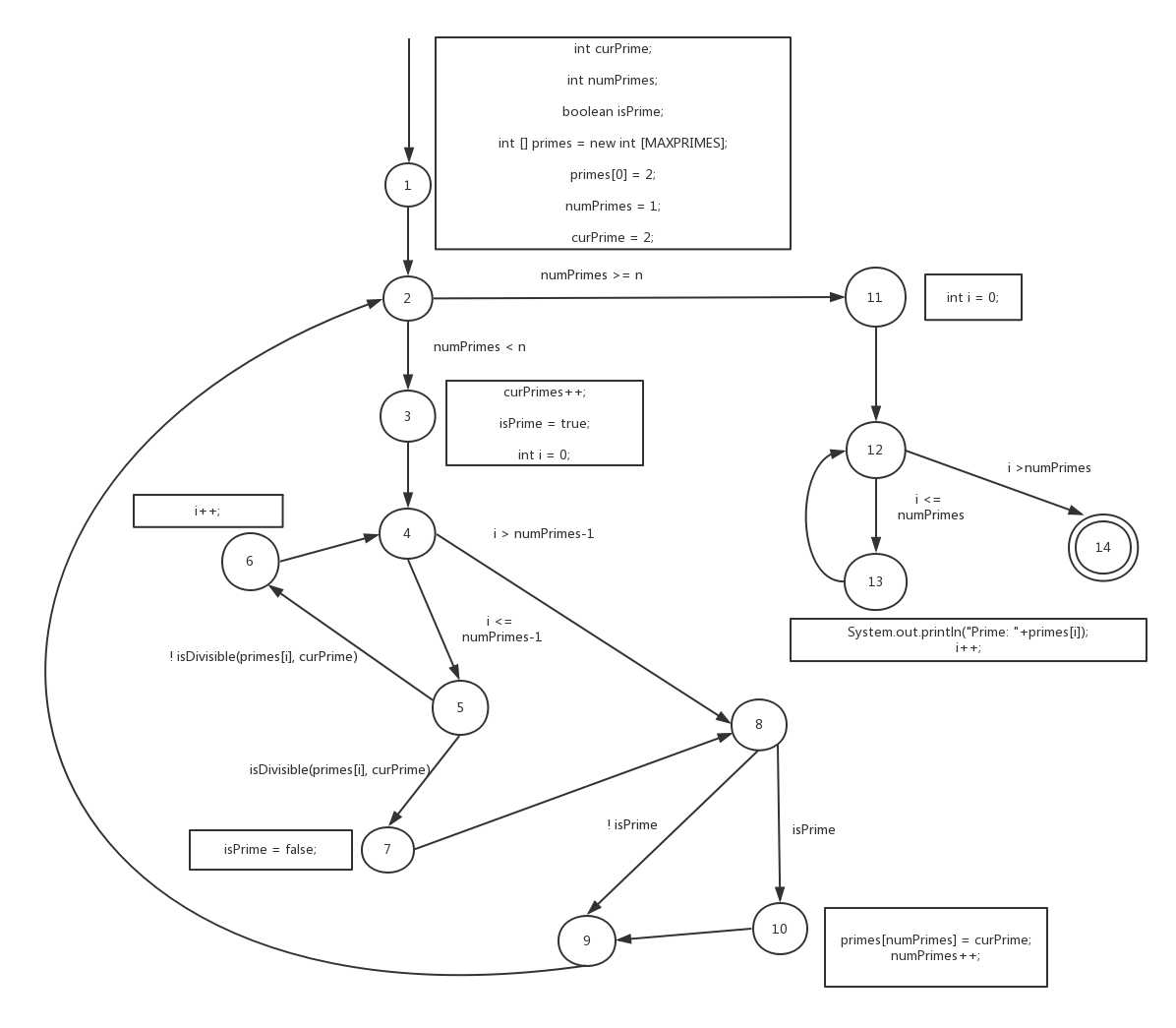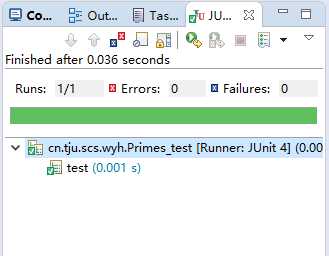标签:sim events setup nump new test 软件测试 write init
The source code:
源代码: /******************************************************* * Finds and prints n prime integers * Jeff Offutt, Spring 2003 ******************************************************/ public static void printPrimes (int n) { int curPrime; // Value currently considered for primeness int numPrimes; // Number of primes found so far. boolean isPrime; // Is curPrime prime? int [] primes = new int [MAXPRIMES]; // The list of prime numbers. // Initialize 2 into the list of primes. primes [0] = 2; numPrimes = 1; curPrime = 2; while (numPrimes < n) { curPrime++; // next number to consider ... isPrime = true; for (int i = 0; i <= numPrimes-1; i++) { // for each previous prime. if (isDivisible(primes[i], curPrime)) { // Found a divisor, curPrime is not prime. isPrime = false; break; // out of loop through primes. } } if (isPrime) { // save it! primes[numPrimes] = curPrime; numPrimes++; } } // End while // Print all the primes out. for (int i = 0; i <= numPrimes-1; i++) { System.out.println ("Prime: " + primes[i]); } } // end printPrimes
a) Control flow

b) The simple fault that t2(n=5) would be more likely to discover than t1(n=3) would is the index of the array out of bounds. It is evident that more large n is, more likely the code will visit out of the array bound.
c) The test case which does not go through the while loop is (n=1). Because the condition of while is numPrimes < n.
d)Node coverage:
TR = {1,2,3, 4,5,6,7,8,9,10,11,12,13,14}
Edge coverage:
TR = {(1,2),(2,3),(2,11),(3,4),(4,5),(4,8),(5,6),(6,4),(7,8),(8,9),(10,9),(9,2),(12,13),(12,14),(13,12),(11,12),(5,7),(8,10)}
Prime path coverage:
TR = {(1,2,3,4,5,7,8,9),(1,2,3,4,5,7,8,10,9),(1,2,3,4,8,9),(1,2,3,4,8,10, 9),(1,2,11,12,13),(1,2,11,12,14),(1,2,3,4,5,6)
(2,3,4,5,7,8,9,2),(2,3,4,5,7,8,10,9,2),(2,3,4,8,9,2),(2,3,4,8,10,9,2),
(3,4,5,7,8,9,2,3),(3,4,5,7,8,10,9,2,3),(3,4,5,8,10,9,2,3),(3,4,5,8,9,2,3),(3,4,5,7,8,9,2,11,12,14),(3,4,5,7,8,10,9,2,11,12,14),(3,4,8,9,2,11,12,14),(3,4,8,10,9,2,11,12,14)
(4,5,6,4),(4,5,7,8,9,2,3,4),(4,5,8,10,9,2,3,4),(4,8,9,2,3,4),(4,8,10,9,2,3,4),
(5,6,4,5),(5,7,8,9,2,3,4,5),(5,7,8,10,9,2,3,4,5),(5,6,4,8,9,2,11,12,14),(5,6,4,8,10,9,2,11,12,14),
(6,4,5,6),
(7,8,9,2,3,4,5,7),(7,8,10,9,2,3,4,5,7),(7,8,9,2,3,4,5,6),(7,8,10,9,2,3,4,5,6)
(8,10,9,2,3,4,5,7,8),(8,9,2,2,3,4,5,7),(8,9,2,3,4,8),(8,10,9,2,3,4,8),(8,10,9,2,3,4,5,6),(8,9,2,3,4,5,6),
(9,2,3,4,5,7,8,9),(9,2,3,4,5,7,8,10,9),(9,2,3,4,8,10,9),(9,2,3,4,8,9),(9,2,3,4,5,6)
(10,9,2,3,4,8,10),(10,9,2,3,4,5,7,8,10),(10,9,2,3,4,5,6),
(12,13,12),(13,12,13),(13,12,14)
Prime path coverage test:
The class Prime(I add a isDivisible function):
package cn.tju.scs.wyh; public class Primes { static int MAXPRIMES = 100; /******************************************************* * Finds and prints n prime integers * Jeff Offutt, Spring 2003 ******************************************************/ public static void printPrimes (int n) { int curPrime; // Value currently considered for primeness int numPrimes; // Number of primes found so far. boolean isPrime; // Is curPrime prime? int [] primes = new int [MAXPRIMES]; // The list of prime numbers. // Initialize 2 into the list of primes. primes [0] = 2; numPrimes = 1; curPrime = 2; while (numPrimes < n) { curPrime++; // next number to consider ... isPrime = true; for (int i = 0; i <= numPrimes-1; i++) { // for each previous prime. if (isDivisible(primes[i], curPrime)) { // Found a divisor, curPrime is not prime. isPrime = false; break; // out of loop through primes. } } if (isPrime) { // save it! primes[numPrimes] = curPrime; numPrimes++; } } // End while // Print all the primes out. for (int i = 0; i <= numPrimes-1; i++) { System.out.println ("Prime: " + primes[i]); } } // end printPrimes public static boolean isDivisible(int num1, int num2){ if((num2 % num1) == 0){ return true; } else{ return false; } } }
The test class Prime_test:
package cn.tju.scs.wyh; import static org.junit.Assert.*; import java.io.ByteArrayInputStream; import java.io.ByteArrayOutputStream; import java.io.IOException; import java.io.InputStream; import java.io.InputStreamReader; import java.io.OutputStreamWriter; import java.io.PipedInputStream; import java.io.PipedOutputStream; import java.io.PrintStream; import java.util.Scanner; import org.hamcrest.core.AllOf; import org.junit.Before; import org.junit.Test; import com.sun.media.jfxmedia.events.NewFrameEvent; import com.sun.org.apache.bcel.internal.generic.NEW; import com.sun.xml.internal.messaging.saaj.util.ByteInputStream; public class Primes_test { ByteArrayOutputStream out; PrintStream ps; ByteInputStream in = new ByteInputStream(); public Primes primes = new Primes(); int [] print = {2, 3, 5}; @Before public void setUp(){ out = new ByteArrayOutputStream(); ps = new PrintStream(out); System.setOut(ps); } @Test public void test() throws IOException { out.flush(); primes.printPrimes(3); assertEquals("Prime: 2\r\nPrime: 3\r\nPrime: 5\r\n", out.toString()); } }
The test case I used is (n=3), because it has reached the 100% coverage rate.


Software Testing (软件测试作业三) HW3 prin
标签:sim events setup nump new test 软件测试 write init
原文地址:http://www.cnblogs.com/wazxser/p/6550670.html